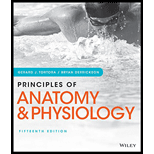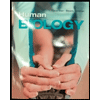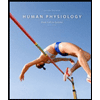
Principles of Anatomy and Physiology
15th Edition
ISBN: 9781119329398
Author: Gerard J Tortora, Bryan Derrickson
Publisher: John Wiley & Sons Inc
expand_more
expand_more
format_list_bulleted
Concept explainers
Textbook Question
Chapter 16, Problem 4CP
What is the difference between rapidly adapting and slowly adapting receptors?
Expert Solution & Answer
Want to see the full answer?
Check out a sample textbook solution
Students have asked these similar questions
What are the differences between slowly adapting and rapidly adapting receptors?
What is the role of Slowly adapting receptors?
Differentiate between the function of rapidly adapting and slowlyadapting receptors?
Chapter 16 Solutions
Principles of Anatomy and Physiology
Ch. 16 - How is sensation different from perception?Ch. 16 - 2. What is a sensory modality?
Ch. 16 - What is a receptor potential?Ch. 16 - What is the difference between rapidly adapting...Ch. 16 - Prob. 5CPCh. 16 - Prob. 6CPCh. 16 - Which somatic sensory receptors mediate touch...Ch. 16 - How does fast pain differ from slow pain?Ch. 16 - Prob. 9CPCh. 16 - 10. What aspects of muscle function are monitored...
Ch. 16 - What are the functional differences between the...Ch. 16 - Prob. 12CPCh. 16 - 13. What type of sensory information is carried in...Ch. 16 - Prob. 14CPCh. 16 - 15. Which parts of the body have the largest...Ch. 16 - Prob. 16CPCh. 16 - 17. Explain the role of the cerebral cortex, basal...Ch. 16 - Describe how sleep and wakefulness are related to...Ch. 16 - What are the four stages of non-rapid eye movement...Ch. 16 - Define memory. What are the three kinds of memory?...Ch. 16 - What is long-term potentiation?Ch. 16 - What is language?Ch. 16 - Prob. 1CTQCh. 16 - 2. Monique sticks her left hand into a hot tub...Ch. 16 - 3. Marvin has had trouble sleeping. Last night his...
Additional Science Textbook Solutions
Find more solutions based on key concepts
More than one choice may apply. Using the terms listed below, fill in the blank with the proper term. anterior ...
Essentials of Human Anatomy & Physiology (11th Edition)
Some people consider Pasteur or Koch to be the Father of Microbiology, rather than Leeuwenhoek. Why might they ...
Microbiology with Diseases by Body System (4th Edition)
The term ‘spore’.
Biology Science Notebook
Knowledge Booster
Learn more about
Need a deep-dive on the concept behind this application? Look no further. Learn more about this topic, biology and related others by exploring similar questions and additional content below.Similar questions
arrow_back_ios
SEE MORE QUESTIONS
arrow_forward_ios
Recommended textbooks for you
 Human Biology (MindTap Course List)BiologyISBN:9781305112100Author:Cecie Starr, Beverly McMillanPublisher:Cengage Learning
Human Biology (MindTap Course List)BiologyISBN:9781305112100Author:Cecie Starr, Beverly McMillanPublisher:Cengage Learning Human Physiology: From Cells to Systems (MindTap ...BiologyISBN:9781285866932Author:Lauralee SherwoodPublisher:Cengage Learning
Human Physiology: From Cells to Systems (MindTap ...BiologyISBN:9781285866932Author:Lauralee SherwoodPublisher:Cengage Learning

Human Biology (MindTap Course List)
Biology
ISBN:9781305112100
Author:Cecie Starr, Beverly McMillan
Publisher:Cengage Learning

Human Physiology: From Cells to Systems (MindTap ...
Biology
ISBN:9781285866932
Author:Lauralee Sherwood
Publisher:Cengage Learning
The Sensorimotor System and Human Reflexes; Author: Professor Dave Explains;https://www.youtube.com/watch?v=M0PEXquyhA4;License: Standard youtube license